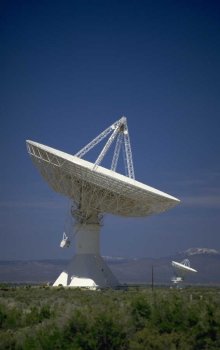10 October 2002
Radioastronomers Measure Sizes Of Distant Planets
by Kate Melville
 Scientists at the Max-Planck-Institute for Radioastronomy (MPIfR) in Bonn were able to determine the diameters of four of the largest and most distant minor planets in our solar system. The largest of them was discovered last June by planetary scientists of the California Institute of Technology (Caltech), who named their object "Quaoar" after a creation myth of the Californian native Tongva people. The radio observations of the Bonn astronomers and their Californian colleagues show that Quaoar has a diameter of 1250 km, making it the largest object discovered in the solar system since the discovery of Pluto in 1930. Minor planets are discovered as slowly moving unresolved sources in optical sky photographs taken with astronomical telescopes. Drs. Frank Bertoldi and Wilhelm Altenhoff from the MPIfR recently used the IRAM 30-meter telescope in Spain to measure the thermal radiation of four of the optically brightest minor planets. From the measured intensity they could derive their sizes, which range between 700 and 1200 km (see table below).
Scientists at the Max-Planck-Institute for Radioastronomy (MPIfR) in Bonn were able to determine the diameters of four of the largest and most distant minor planets in our solar system. The largest of them was discovered last June by planetary scientists of the California Institute of Technology (Caltech), who named their object "Quaoar" after a creation myth of the Californian native Tongva people. The radio observations of the Bonn astronomers and their Californian colleagues show that Quaoar has a diameter of 1250 km, making it the largest object discovered in the solar system since the discovery of Pluto in 1930. Minor planets are discovered as slowly moving unresolved sources in optical sky photographs taken with astronomical telescopes. Drs. Frank Bertoldi and Wilhelm Altenhoff from the MPIfR recently used the IRAM 30-meter telescope in Spain to measure the thermal radiation of four of the optically brightest minor planets. From the measured intensity they could derive their sizes, which range between 700 and 1200 km (see table below).
On October 7 their Caltech colleagues presented their discovery of Quaoar at the annual meeting of the Planetary Sciences Division of the American Astronomical Society, which is held in Birmingham, Alabama. There they also present a direct size measurement of Quaoar from optical images obtained with the Hubble Space Telescope. This unique and first such observation confirms the prior radio size measurement.
The four minor planets are members of a ring of some 100,000 objects in the outskirts of the solar system, beyond Pluto at distances over 4 billion km from the sun, over 30 times the distance between earth and sun. The objects in this "Kuiper belt" circle the sun in stable orbits with periods of about 300 years. In the mid of last century, the existence of a ring of small planetisemals was first suggested by the astronomers Kenneth Edgeworth (1880-1972) and Gerard P. Kuiper (1905-1973), but the first discovery of an "Edgeworth-Kuiper belt object" (EKO) was not until 1992. By now, over 550 EKOs are known.
